Rhubarb, a plant well known to pie and dessert lovers in Nebraska, has a long history in this state. Its use as a substitute for fruit in a newly settled country where fruit growing was limited made it popular with many pioneer housewives. Although the leaves were poisonous, the fleshy stalks were harvested and used for a variety of foods and medicines.
Rhubarb was used for medicinal and cosmetic purposes long before it found its way into kitchens and onto dining tables. The Columbus Journal on May 12, 1908, noted: “Though a vegetable, rhubarb is used in every respect as a fruit. Eaten stewed, so that the acids are tart in it, the stalk acts as a foe to gout and to rheumatism, for it neutralizes the uric acid that causes these things. It is also a specific for the complexion. Its acids fight valiantly with the noxious humors and gases in the body that otherwise would find outlet in the shape of rough and pimpled skin.” A beauty treatment popular in the days before commercial products were widely available recommended a shampoo of rhubarb, honey, and wine for enhancing blonde hair.
The most popular use of this versatile plant was in pies and desserts. An early recipe for “Pie Plant Pies” from the Nebraska Advertiser (Brownville), of June 11, 1874, directed: “Peel the stems of the rhubarb and slice them in half-inch lengths, holding several stems in the hand at one time. With these fill the pie, sweetening it generously-about the same as for lemon pie, a small teacupful of sugar for a medium-sized pie-anointed with a great spoonful of water, dust over this a little dry flour, to thicken the juice a little, cover it with the upper crust and bake it slowly and thoroughly.”
Other culinary products made with rhubarb included beverages, jams and jellies, compotes, fritters, soufflés, cobblers, puddings, and sherbet. In 1896 S. P. Merman won a first prize for his rhubarb wine exhibited at the Douglas County Fair. The Omaha Daily Bee advised readers on May 1, 1901: “Rhubarb will make a delicious wine, which is a much safer beverage to indulge in if you wish to avoid unpleasant after effects.”
One drawback of cooking and baking with rhubarb was the amount of often scarce sugar needed to sweeten its tart taste. Some housewives substituted honey or molasses, if available, or added a pinch of soda so that the dish would require less sugar. Although fruit is now more readily available to Nebraskans than in earlier days, rhubarb is still found in grocery stores and home gardens, with rhubarb pie a Nebraska favorite.

Photographer Solomon D. Butcher depicted a Custer County rhubarb patch and orchard in the early 1900s. The large leaves of the rhubarb plants are visible near the fence. NSHS RG2608-2204

From the Kearney Daily Hub, May 2, 1930.



